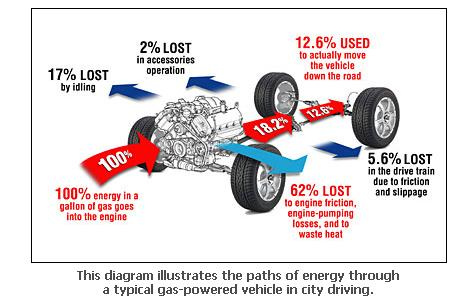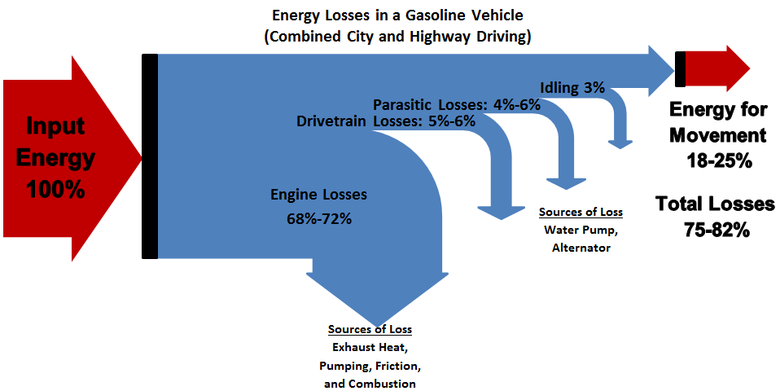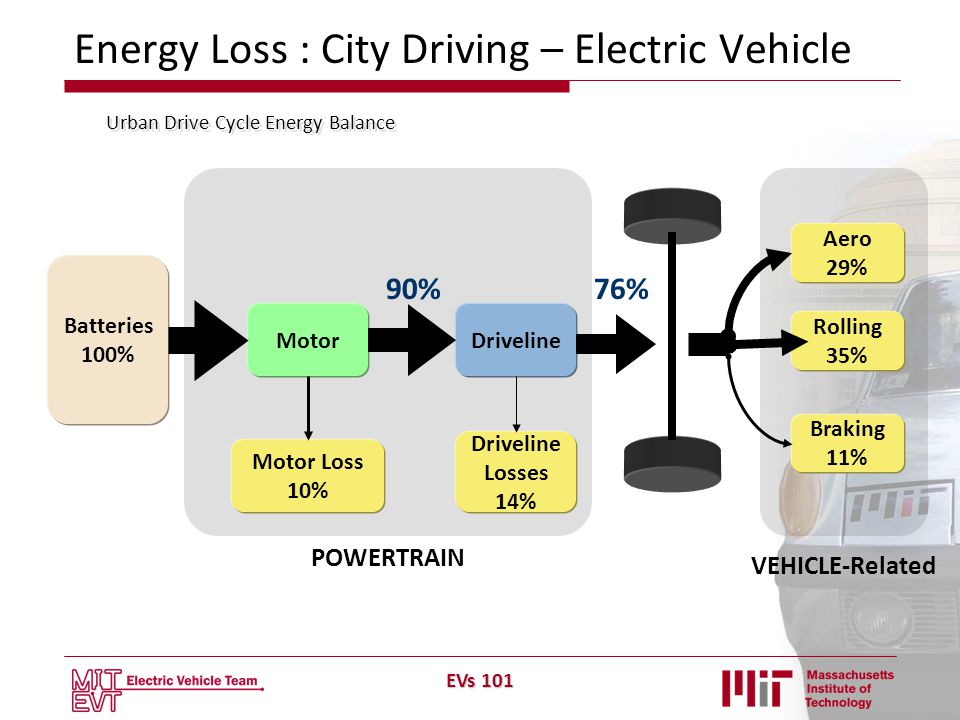Cars: Tech
Reading to date:
At this point you have hopefully read the chapter on Cars: Tech from David's book before we start this discussion. This is a dense chapter that explores the energy consumption and efficiency of our stadard cars in greater detail.
David offers a number of different perspectives on where the energy that is in the gasoline we put in our cars ends up. Here are two different sort of graphics that show the same perspective in different ways.

What does this make you think? Which of these losses might we be able to do something about?

Does this adding any information to your thinking?

Let's look back and forth and see if these different analyses are consistent with each other. What do you think?
Things to Notice:
Thermodynamic Loss: The maximum engine efficiency is determined by thermodynamics and depends on the temperature at which the fuel is burned and the temperature of the exhaust gases. Even those 60-70% loss at the engine seems outrageous it is actually about as good as you can do. Diesel engines run a bit hotter which is mostly why they are more efficient. It is important to note that there is a trade off. Because diesel engines run hot they must be made of steel which makes them heavy which costs energy on the road. Fuel efficiency in cars has increase partly due to making the car lighter by making the engines out of aluminum but that limits the temperature you can operate at without melting the engine block. A modern engine is very well designed and there is not much we can do to reduce this loss. So many trade offs......
Idling Loss: When we drive our cars in the city we spend at least some time sitting at stop lights just idling the car. The more stop and go the traffic the more idling we typically do. This can cost a lot of energy (sometimes as high as 15-20%). Hybrid vehicles, and even some of the newer ICE vehicles, actually turn off the engine while the car is stopped and then restart it when you put your foot on the gas. The engines that can do this successfully have a different design so don't assume your old car can do this. Clearly this is NOT an issue when you are driving on the highway.
Parasitic Loss: This is energy that you spend to accomplish other important tasks in the vehicle like keeping your battery charged, running the lights, operating the audio system, and the AC. Again, there are limits to what we can do to reduce these losses. LED lights use less energy but are pretty expensive (trade off), no AC is an option but that's a trade off too. Audio systems don't use all that much for most of us and keeping the battery charged is not really an option. We can make small reductions to this loss but it's not a big player even if we don't.
Drive Train Losses: All the spinning metal and differentials in a typical rear wheel drive vehicle cost energy to spin. Aside from moving to front wheel drive we can't do a lot about this. All wheel drive has even more drive train losses. We have limited ability to improve this situation.
Take Home (ICE):
About 25% of the energy we put in the gas tank of an ICE (Internal Combustion Engine) vehicle is actually used to move it down the road. The remaining 75% is 'lost' as heat or other losses in the system. While we can probably reduce those losses by 5% or 10% that's about the best we can do. A modern vehicle is a well engineered machine!
Mathematical Check:
As we calculated last time it takes 40 kWh/d/p to drive our 'average' car around. This means that only 10 kWh/p/d of that energy is actually moving us down the road. That energy is worth $1.00 in electrical energy. It's a shame that the other $3.00 that we spend on the gas isn't really doing much for us except in the winter when we need the heat:)
Electric Vehicles:
Now let's consider an electric vehicle....

In what ways is this different? In what ways are the numbers similar?
Electric Motors are significantly more efficient at converting the source of energy (electric energy) to the turning of the drive shaft. Once the energy gets to the wheels a car doesn't car what's making the energy to turn the wheels. The drive train losses are a bit higher than an ICE vehicle due to other electrical losses in the system.
Take Home (EV):
A helpful way to think about electric vehicles is that their energy use is the opposite of ICE vehicles. 75% of the energy we put in the battery ends up moving the car down the road.
Do the Math:
A basic assumption here is that the energy it takes to move the vehicle down the road is the same (roughly) for all vehicles of the same size and weight. This allows us to make an important comparison. Let's take the 10 kWh/p/d that we actually use to roll our cars down the road. For an ICE vehicle 10 kWh/p/d = 25% of the energy input. In math speak we would say......
10 kWh/p/d = 0.25 (energy input)
(energy input) = (10 kWh/p/d)/0.25 = 40 kWh/p/d
Our energy input for an ICE vehicle is 40 kWh/p/d which is what you would expect (and now the math connects it). for an EV (electric vehicle) the same 10 kWh/p/d = 75% of the energy input. In math speak we would say....
10 kWh/p/d = 0.75 (energy input)
(energy input) = (10 kWh/p/d)/0.75 = 13.3 kWh/p/d
Our energy input for an EV is only 13 kWh/p/d for our daily driving. This is pretty remarkable. We can cut our energy use (for driving) by more than half if we use EV's. Bullet point that. That's why so many countries are moving hard to EV's.
HW: Cars Tech
So... we've done the calculation that illustrates the reduction in energy input that you need to move an EV down the road compared to a standard vehicle. Now consider the related question about where that energy input comes from in the case of an EV. Looking the Sankey plot at the bottom of this page how do we make most of the electricity in this country? Will having an EV reduce you actual use of fossil fuels under the circumstances? Determine the efficiency with which we produce electricity from the plot. Then determine how many kWh of fossil fuel energy will I need to use to make the 13 kWh of energy I need to drive my car. In this scenario is my EV better for the environment overall? What would change that assessment?
EV Issues:
Yes, there are EV issues but before we get to that discussion let's finish our explorations of vehicles in general separate from what energy source makes them go.
Where the Energy Goes:
The last graphic showing energy losses in an EV also shows us where the energy goes that is actually moving the car down the road. The three primary energy costs in every vehicle are rolling resistance, aerodynamic drag (wind resistance), and braking losses.
Braking Losses:
You kind of can't get away from this one. You gotta slow down sometimes. An interesting distinction between ICE vehicles and EV's and Hybrids, that you may have heard about, is regenerative braking. In an EV we can use the electric motor that drives the vehicle in reverse as a generator when we want to slow down. We don't get all the energy back but about 30% of the energy we would normally lose can be recovered and put back into the battery. It turns out to not be an enormous amount of energy but it also saves on brakes. My 2002 Prius has never had it's brakes replaced even after 340,000 mi. Last time I was getting tires I still had 60% of the brake pads left.
Rolling Resistance:
The Wiki article on rolling resistance does a good job. Here are the things we will specifically look at. The first is the formula for rolling resistance explaining the big picture. Think about when you go to ride a bike with low tire pressure. You probably remember how much extra effort you have to provide. This effect is still there when the tires are pumped up but you don't notice it as much. You may also be aware that knobby off road tires take more energy to ride than some road tires. All part of the same phenomena.
F = Crr N
where
F is the rolling resistance force which is slowing you down
Crr is the coefficient of rolling resistance. This depends on the tire and the road and is different in each setting
N is what physics calls the normal force but most of us think of as the weight.
Notice that it depends on 2 things, the weight of the vehicle (called the normal force) and a magic number called the coefficient of rolling resistance. Take a good look at the table of values for Crr in the Wiki article. Notice that it depends on the material of the 'road' and the material of the 'tires'. Look at the differences between circumstances like trains, bicycles, and cars. What do these differences mean?
You will notice that steel wheels on steel rails (a train) has a very low coefficient of rolling resistance (aboyut 50 x better than car tires). This is way we can move so much heavy freight relatively efficiently by train. You'll perhaps remember the BNSF (Burlington Northern-Santa Fe) railway ad that states that they can move a ton of freight 486 miles on a single gallon of fuel. The very low Crr is part of the reason.
A last comment. You are aware that force generated from rolling resistance is not large under good circumstances. I assume everyone has had to try and push their car on the flat at one time or another. It's totally doable especially if you remember to put it in neutral. The reason it matters so much is because it's always there no matter how fast or slow you are going.
Rolling Resistance Take Home:
Keep your tires fully inflated. It really does affect your fuel efficiency. It mostly depends on the weight of the car. Heavy cars squish their tires more and requires more effort to roll them.
Air Resistance:
Air resistance (aero resistance in the UK) is sometimes called air drag. First we need to look at the physics of drag in general which is described in gory detail in the Wiki drag article . Again lets look at the formula and notice some important features.
FD = 1/2 ρ v2 CD A
It depends on ρ which is the density of the fluid you are pushing through. I once saw a Junkyard Wars episode where they had to drive a vehicle underwater and even at slow speeds pushing through water taxed the vehicles tremendously. It depends on the square of the speed (v) which makes it get much bigger as you go faster. This also means that if you drive 10% faster your energy use increases by 20% because of the square. This is why you can tell if you commute to Bend or Redmond at 65 mph compared to 60 mph. Finally it depends on the frontal area (A) of the vehicle which makes large cars and trucks experience much more. It also depends on a magic number called the drag coefficient. This number depends on the shape and smoothness of the vehicle.
Since we're interested in cars it's interesting to look at drag coefficients for cars of different kinds. Wiki has kindly documented those drag coefficients. What do you notice about them?
We can't do anything about the density of air and CD is pretty consistent for almost every vehicle. That means the primary tools we have to reduce this energy cost in our vehicles is to reduce the cross sectional area of the vehicle (this is why bike racers crouch over the handlebars) and slow down. One of these is less likely no?
Triple Trailers and Trains:
A important feature of air drag to notice is that it only applies to the 'front' of the vehicle. When you hook 3 semi trailers together (triple trailer) you only increase your rolling resistance. Only the front vehicle pays the air drag cost. This is why 'drafting' behind a truck totally reduces your air drag -- its being paid for by the truck! DON'T do this since it is very dangerous but you can see why it is tempting. Drafting in professional bike racing and car racing is a very real advantage especially when the difference in performance among the pro's is typically very small. Trains are another example. The only part of the train that has to push through the air is the engine. Everything else only has to 'pay' the cost of rolling resistance which is ridiculously small for a train. This is the other reason BNSF can move 1 ton of freight 486 mi on a single gallon of fuel.
Here's an article that looked at the benefits of drafting in bike racing and how close one needs to be.
Air Drag Take Home:
Slow down and drive a small car!
Putting it All Together:
David captures this discussion in the following plots from the tech chapter. What you can see is that at low speeds the energy cost to drive a car is all about the rolling resistance which is mostly about the weight. At high speeds the energy cost is almost entirely about the air resistance. This is also the difference between city and highway driving.

for bikes with same units

Consider the plots above. An important difference between cars and bikes (not on the plots) is that a car is mostly vehicle and a little bit passenger while a bike is mostly passenger and a little bit vehicle. Because of this the car takes a lot more energy to go 100 km which makes an honest comparison difficult. A car has a mass ('weight') of 1200 kg which is the same as about 12 bikes with rider. Divide the numbers on the car plot by 12 and compare them to the bike. Is the bike really that much more efficient than a car when you look at it this way? What do you think this means?
Urban Cars:
If we live where we mostly drive a low speed in stop and go traffic a light car is the most effective way to be more efficient. This is usually accomplished by making urban vehicles small though it's the weight not the size that matters. Think about the Honda Fit, the Smart Car, Mr Bean's Mini, or some of those other tiny cars you've seen.
Highway Cars:
If you only drive on the highway the most important thing you can do to help is keep the profile of your car small. A Honda Fit is a good example, a Hummer is not, a Lamborghini is great though a little pricey. Going slower also helps a lot if you can manage it.
Does It All?
If you want a car that does it all it needs to be light AND small in cross section.
Self Tests:
Can you tell what these car designs are optimized for -- highway, urban, or both?
others??
HW: Cars Tech
Find two other vehicle designs (not any of the ones linked above). Identify, in one design, the feature(s) that suggest it was optimized for highway driving. For the other design identify the feature(s) that suggest it was optimized for urban driving.
We could talk about cars and car design and what might be possible for a long time. Why is this an important topic in our energy discussion? If we cut our energy use for tranportation in half would that matter?

Assignment: HW Cars Tech
Complete and assemble your solutions to all the HW problems (3) listed here showing all the steps in your solutions. Scan to a pdf and turn in on LMS. Please review HW format expectations for guidance about your homework solutions.
Reading Ahead:
Next you will read the chapter on Wind from David's book before we start the next discussion. This is a quick chapter that lays out the basic considerations for wind as a source of renewable energy.
